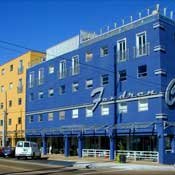Many people in Mississippi put significant effort into successfully reviving downtown areas and making them welcoming places. But to get downtown, people often have to drive past worn-out, unoccupied strip malls overgrown with weeds. Leland Speed, executive director of the Mississippi Development Authority, said most strip malls have a lifespan of only 15 to 20 years before the anchor store leaves and the community is stuck with a vacant building.
Enter the Retail Center Revitalization Program, a pilot program from MDA to rehabilitate old strip malls and make them useful again. MDA will award grants of up to $50,000 to help community developers turn concrete eyesores into attractive, useful spaces.
At a Sept. 7 summit to unveil the program, John Poros, director of the Carl Small Town Center at Mississippi State University, said strip malls became popular after World War II, but now the United States simply has too much retail space, especially with e-commerce luring many people to shop online. Communities, he said, are left with abandoned buildings without a shred of landscaping except for the grass growing through the cracks in the pavement out front. Shoppers are looking for a pleasant experience, not just convenience, and that is what the Retail Center Revitalization Program aims to provide.
The pilot program will award grants for about four projects to test its effectiveness. MDA is taking applications from "planning and development districts" that are working in partnership with local government and property owners. The total cost of funded projects must be more than $100,000, and the strip center must be located on a main thoroughfare leading into a downtown area. Speed said renovated buildings could have a range of possible uses other than retail, such as medical centers, municipal offices or police stations.
At the summit, developers shared success stories and ideas for the types of projects MDA is looking for. Mike Peters, owner of Peters Real Estate, shared how he transformed a vacant office building on State Street into Fondren Corner. The building now houses restaurants, boutiques, offices and apartments. Peters said cities should change zoning regulations to allow "mixed-use" developments that move living, recreational and workspaces closer together. That way, he said, people are in the area at all times, unlike a building of just offices that sits empty after business hours.
"This building has a life that none of these uses would have on its own," Peters said. "... There's always something going on; there's never a dead time."
Joy Foy, director of asset development at MDA, said a project like Fondren Corner would not qualify for the grant because Fondren is considered in town instead of on a road leading into a downtown area. But she wanted people at the summit to see how Fondren Corner went from being just an office building to housing different types of tenants. "You don't necessarily have to rebuild what's there; you can make it something new and something different," she said.
To foster vibrant retail areas, Poros said developers should build shopping areas with plenty of sidewalks, landscaping and even small parks, and should host events to make retail part of the community. Cities can also reduce the amount of land zoned for retail so stores are in more concentrated areas.
The goal, Poros said, is to design for "park-once connectivity" so that shoppers can safely walk from store to store instead of having to get in their car and drive. Designing pedestrian-friendly retail areas helps businesses as well as customers hurting from high gas prices, Poros said. As people stroll past store windows, they get a better look at what businesses have to offer. But all of that involves planning and building shopping centers better.
For information on the Retail Center Revitalization Program, email [e-mail missing] or visit http://www.mississippi.org and click on Community and Asset Development, then Asset Development Programs.


